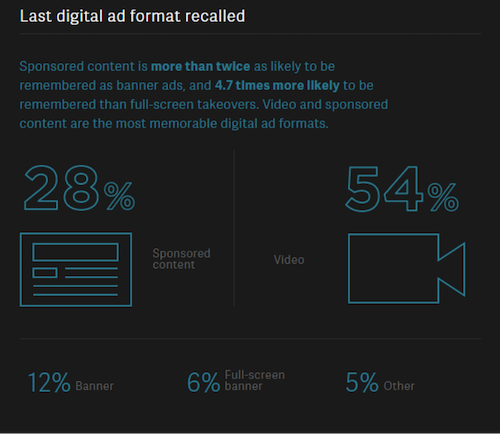The consumption of video content is growing at breakneck speed. Cisco has predicted that by 2017 Internet video traffic will have increased fourfold, and Nielsen reports that 64% of marketers expect video to dominate their content strategies in the near future.
But why video? For one, it’s the perfect complement to traditional written content. Plus, people are more likely to remember video content, as Quartz shows below.
Video is also measurable. Even if you host your videos on YouTube rather than directly on your site, you’ll still have access to some powerful analytics.
But enough about why. Let’s talk about how.
What Makes Good Video Content
Since video is just one piece of your overarching content strategy, it’s imperative to keep your story consistent. And when I say consistent I mean customer-focused and brand appropriate.
Is your brand bubbly and exciting? Can you do that on camera without cracking the glass? Or perhaps you write with a bit of sarcasm. Can you make those same deadpan jokes without sounding like a jerk? Brand voice can become much trickier when it’s placed on camera.
From a creative perspective, keep it simple at first. Prioritize clarity and make it the presentation as intuitive as possible—just like your written content. This means considering what translates well to video and what doesn’t.
Five minutes of reading doesn’t seem like a huge commitment, but five minutes of boring video can be a disaster. That said, boring is a relative term. Many of those ubiquitous TED Talks are around 18 minutes long. They’re successful in part because the length matches the subject matter and audience.
Check out Seth Godin doing his best Steve Jobs:
Finally, consider the position each video’s target audience occupies in the sales funnel. Longer, more in-depth content is appropriate for mid-to-bottom funnel audiences, while shorter, broader videos will naturally appeal to people just learning about your product or service.
How to Repurpose
The actual content repurposing process involves going back through your existing content and looking for opportunities to make a complementary video.
Start with some of your cornerstone content. This puts you in the best position to succeed. You already know your audience appreciates those subjects, so transferring your best stuff to video gives you another opportunity to publish pieces that resonate.
Once you’ve selected your topics, use these three techniques to formulate your new video content.
#1: Add a Human Element
Humans like to see other human faces. It’s one of the reasons baby’s smile when they see their parents. This disposition also leads us to use another person’s face as a source for information and authenticity.
Having someone explain an overview of a popular blog post or successful guide on camera can affect how your audience consumes the content. What was once an intimidating whitepaper with myriad statistics is now a casual conversation with a person who has a lot of knowledge about the subject.
For instance, here’s how we turned our 18-page report about wearable health technology into a 2-minute video with the study’s author:
Upcoming events and marketing campaigns make for nice topics of discussion as well. Be careful not to rely just on a human face, though. Add in other relevant visuals to maintain viewer interest.
#2: Explain a Compelling Point Quickly
Instead of providing a general overview for one specific piece of content, you can also address a topic that’s found consistently throughout your content.
Giving your audience a quick yet digestible clip provides educational information while also making the content shareable. Not much commitment is required and the payoff is gratifying.
For example, here’s the definition of content marketing:
These videos should remain brief, because they establish context that makes exploring more in-depth content less intimidating.
While the example above features an actual person on camera, that’s not a requirement for these videos. If you have a strong graphics department, animation can be a great tactic, too.
Just make sure the point you’re covering is consistent across the majority of your content, or effectively piques the interest of your audience.
#3: Overanalyze One Key Topic
While the first two points work well for top-of-the-funnel content, video can also be used to great effect when covering topics in greater detail.
To easily identify topics for greater analysis, examine your content for key points that you could expand upon—whether that’s from your latest listicle, a 50 page eBook, or a podcast with industry experts.
The whiteboard has become a favorite video format for detailed explanations because it substantially increases memory recall, which makes it easier to consumer longer videos. Whiteboards can be very effective, but it’s important to do a lot of planning up front so the narrative of your video remains consistent and concise.
If you’re working with products, then making a demonstration video is another option. Your audience at the top of the funnel will enjoy reading about concepts for a while, but at a certain point they need to see the goods.
Demonstration videos still feature a human element through the narrator’s voice, but also give viewers a personal experience with the product. Software how-to videos are also a variation on this concept.
Here’s one about project management software Basecamp:
You’ll need some screencast software to pull these off, but they can be very useful for your audience. Try to avoid too many hard cuts to keep the visuals and narration smooth.
***
While these techniques aren’t the only ones around, they do offer broad frameworks that allow for a good deal of creativity without having to start from scratch. Video’s happening, and the ROI can be big. Start thinking of which content translates well, and you could see a nice return.


